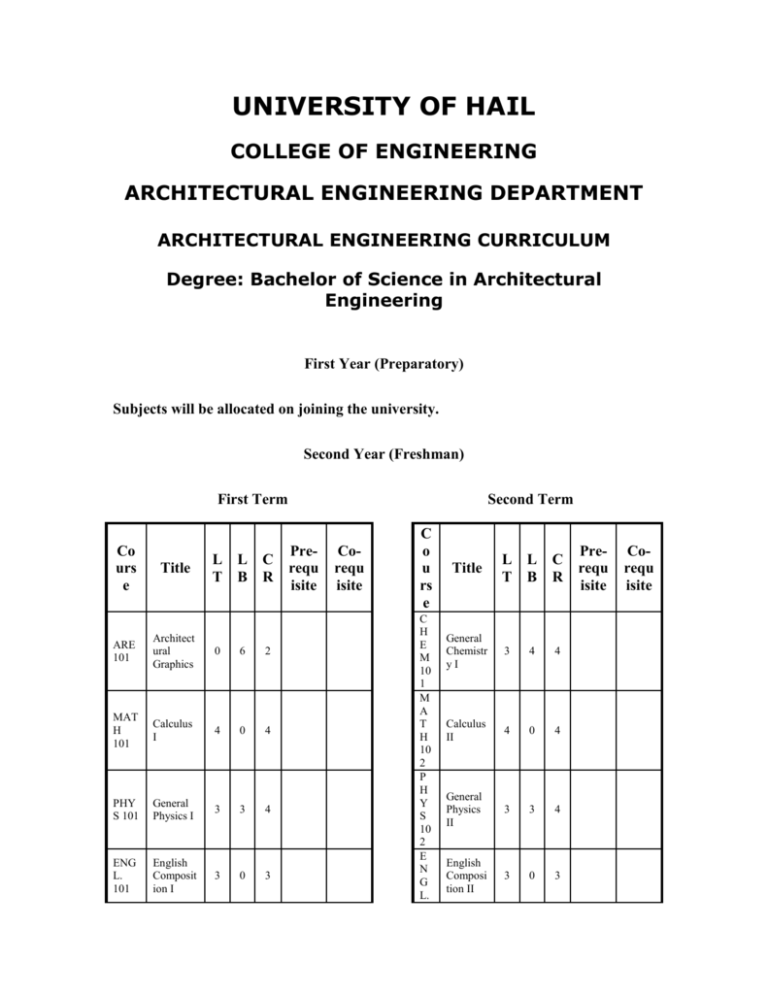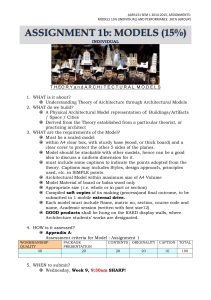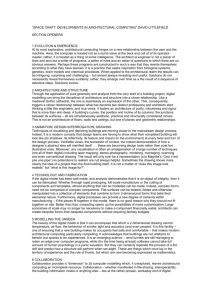here
advertisement

UNIVERSITY OF HAIL COLLEGE OF ENGINEERING ARCHITECTURAL ENGINEERING DEPARTMENT ARCHITECTURAL ENGINEERING CURRICULUM Degree: Bachelor of Science in Architectural Engineering First Year (Preparatory) Subjects will be allocated on joining the university. Second Year (Freshman) First Term Co urs e Title ARE 101 Architect ural Graphics 0 6 2 MAT H 101 Calculus I 4 0 4 PHY S 101 General Physics I 3 3 4 ENG L. 101 English Composit ion I 3 0 3 L L T B C R Second Term Prerequ isite Corequ isite C o u rs e C H E M 10 1 M A T H 10 2 P H Y S 10 2 E N G L. L L T B C R General Chemistr yI 3 4 4 Calculus II 4 0 4 General Physics II 3 3 4 English Composi tion II 3 0 3 Title Prerequ isite Corequ isite IAS 111 Belief and its Conseque nces 2 0 2 IAS 101 Practical Grammar 2 0 2 PE 101 Physical Educatio nI 0 2 1 TOT AL 14 11 10 2 IC S 10 3 P E 10 2 Introduct ion to Computi ng 2 3 3 Physical Educatio n II 0 2 1 15 12 19 T O T A L 18 Third Year (Sophomore) First Term Co urs e Title L L T B C R ARE 211 Building Materials 2 3 3 ARE 222 Computer Appl. Bldg. Design 1 3 2 ARC 110 History of Architect ure MAT H 201 Calculus III 3 0 3 ME 203 Thermod ynamics 3 0 3 CE 201 Statics 3 0 3 CE 261 Surveyin gI 1 3 2 2 0 2 Second Term Prerequ isite Corequ isite ARE 101 C o u rs e A R E 20 2 A R E 21 2 M A T H 20 2 E E 20 2 C E 20 3 C E 23 0 L L T B C R Prerequ isite Architec tural Design I 0 9 3 ARE 101 Construc tion Systems 3 0 3 ARE 211 Elem. Diff. Equation s 3 0 3 2 3 3 3 0 3 3 0 3 Title Fund. Of Electrica l Systems Structura l Mechani cs I Engineer ing Fluid Mechani cs Corequ isite TOT AL 15 9 T O T A L 18 14 12 18 Fourth Year (Junior) First Term Co urs e Title ARE 303 Working Drawing 0 ARE 322 Building Mechanic al Systems 2 ARE 320 Architect ural Acoustics MAT H 321 Intro. to Numerica l Computin g C R Prerequ isite 9 3 ARE 202 ARE 212 3 3 PHYS 102 2 PHYS 102 L L T B 1 3 3 0 3 CE 305 Structural Analysis I 3 0 3 EE 308 Building Electrical Systems 2 0 2 ENG L. 214 Tech. Report Writing 3 0 3 14 15 19 TOT AL Second Term Corequ isite C o u rs e A R E 30 1 A R E 32 5 A R E 34 5 C E 31 5 S T A T 31 9 IA S 20 1 IA S 21 2 T O T A L L L T B C R Prerequ isite Architec tural Design II 0 9 3 ARE 202 Building Illuminat ion 1 3 2 PHYS 102 ARE 322 ME 203 Title Principle s of HVAC 3 0 3 Reinforc ed Concrete I 2 3 3 Probabili ty & Statistics 2 3 3 Writing for Prof. Needs 2 0 2 Professi onal Ethics 2 0 2 12 18 18 Corequ isite Summer Semester Co urs e Title ARE 350 Cooperat ive Work Program L L T B 0 0 C R Prerequ isite 0 ENGL 214 Junior Standi ng Corequ isite Fifth Year (Senior) First Term Co urs e Title ARE 351 Continuat ion of Coop Work L L T B 0 0 C R 9 Second Term Prerequ isite Corequ isite C o u rs e A R E 41 3 A R E 43 1 C E 35 3 IA S 30 1 TOT AL 0 0 9 IA S 32 2 T O T A L L L T B C R Prerequ isite Construc tion Manage ment 3 0 3 Senior Standi ng Building Econom y 3 0 3 Junior Standi ng 3 3 4 2 0 2 2 0 2 13 3 14 Title Geotech nical Engineer ing I Languag e Commu nication Skills Human Rights in Islam Total credit hours required in Degree Program: 133 + (Preparatory Year) COURSES DESCRIPTION Corequ isite LEVEL 1XX COURSES ARE 101 - Architectural Graphics: (0-6-2) - Prerequisite: None The course initially introduces the discipline of Architectural Engineering and the role of Architectural Engineers in the process of building design, systems' integration, construction and operation. Graphical representation methods and techniques in architectural design and presentation are introduced. Drawing tools and materials; architectural drafting conventions; orthographic projections and views, their types and use in building presentation. Shades and shadows techniques. Freehand sketching and model-making techniques. Introduction to computer graphics using simple software tools. LEVEL 2XX COURSES ARE 202 Architectural Design I: (0-9-3) - Prerequisite: ARE 101 This course introduces the design process in the form of phases, activities, and parties involved. Topics covered include: Description of each phase, activities and objectives; models for problem-solving process in design utilizing graphic thinking. Problem definition, developments of alternatives, evaluation, selection of solution and communication of a design project are introduced, explored and exercised through both abstract sketches and definitive concrete designs to solve simple design problems. Design problems of complete but simple buildings are introduced. Considerations of building function, construction materials and systems, cultural, environmental constraints, and climatic influences are emphasized. Individual design thinking is encouraged throughout the studio work. ARE 211 Building Materials: (2-3-3) - Prerequisite: None Properties, behavior, and selection of building materials including wood, laminates, cements, aggregates, concrete, masonry mortar, steel, and finishing materials. Structural and architectural use of traditional and modern building materials. Introduction to basic methods of construction; excavation, foundations, building systems, and construction equipment and general techniques in wood, masonry, and concrete construction. New building materials. Visits to building sites and manufacturers. ARE 212 Construction Systems: (3-0-3) - Prerequisite: ARE 211 Construction systems including foundation, superstructure, enclosure (walls and roofs), interior finishes, partitions, and ceilings. Construction and detailing of site-built and prefabricated systems. Selection methods and criteria for appropriate design as a function of climate and energy use, labor and material availability, maintenance and replacement patterns, safety, functionality, and cultural context. Course material comprehension is ensured through submission of sketches, to-scale detail drawings and model-development of the introduced systems. ARE 222 - Computer Applications in Building Design: (1-3-2) - Co-requisite: ARE 101 Introduction to Computer-Aided Drafting and Design which includes: 2D drawings, 3D modeling, rendering, and Image processing. Major CAD drafting, and presentation software tools will be used for the production, management, and presentation of project information. Introduction to utilization of modeling and simulation software tools in Architectural Engineering. LEVEL 3XX COURSES ARE 301 Architectural Design II: (0-9-3) - Prerequisite: ARE 202 This course is a continuation of a two-semester sequence of design studios. Introduction and appreciation of the design process through dealing with more complex buildings and lager project sites. The concept of building design as a multi-disciplinary approach is introduced. Integration of structural, mechanical and environmental control systems with the building function, form and spaces’ organization is emphasized. Basic elements of architectural form and space and how they can be manipulated, organized in the development of a design concept and their visual implications are explored. ARE 303 Working Drawings: (0-9-3) - Prerequisites: ARE 202, ARE 212 An introduction to the production of construction documents used in the building industry. A preliminary building design is developed to include detailed materials, and construction information. A set of drawings is completed including floor plans and elevations, site, foundation, framing and roof plans and details, wall and roof sections and details, interior finish elevations and details, and door and window schedules and details. Drawing skills are developed, office management issues are discussed. ARE 320 Architectural Acoustics: (1-3-2) - Prerequisite: PHYS 102 Introduction to architectural acoustics. Room acoustics and noise sources, measurements, and control. Acoustical properties of materials and room shapes. Sound absorption and transmission. Computer applications in room acoustics simulation. ARE 322 Building Mechanical Systems: (2-3-3) - Prerequisite: PHYS 102 Introduction to basic concepts, terminology and design methods for building mechanical systems. Thermal comfort, building thermal performance, and heating & cooling load calculation procedures. Fire protection systems and smoke control. Water supply and distribution systems; Waste and drainage systems. Vertical transportation systems. Computer applications. ARE 325 Building Illumination: (1-3-2) - Prerequisite: PHYS 102 Concept of light, vision, and color.Luminaries and lamps.Lighting system design procedures; calculation and measurement techniques, evaluation of interior lighting quality, and daylighting.Computer applications in artificial and daylighting analysis and design. ARE 345 Principles of Heating, Ventilating, and Air-Conditioning: (3-0-3) Prerequisite: ARE322, ME203 Fundamental principles and engineering procedures for the design of heating, ventilating, and air conditioning systems; HVAC system characteristics; system and equipment selection; duct design and layout. Energy conservation techniques. Computer applications. ARE 350 Coop Work Program: (0-0-0) - Prerequisites: ENGL 214, Junior Standing ARE 351 Continue Coop Work: (0-0-9) A continuous period of 28 weeks is spent in the industry to acquire practical experience in the Architectural Engineering under the supervision and guidance of the employer and the academic advisor. During this period the student gains an in-depth exposure and appreciation of the Architectural Engineering profession. The student is required to write a detailed report about his training period under the regulation of the ARE department. LEVEL 4XX COURSES ARE 413 Construction Management: (3-0-3) - Prerequisite: Senior Standing A survey of Construction Management: Basic concepts, preparing the bid package, issues during construction phase, construction contracts, legal structure, time planning/control. Project cash flow; project funding, equipment ownership, equipment productivity, construction operations, construction labor, materials management and safety. Types of specifications, technical division, changes, bonds, liens, general conditions, special conditions and contract documents. ARE 431 Building Economy: (3-0-3) - Prerequisite: Junior Standing Basic concepts of building economics: initial cost, life cost in use, cost and benefit ratio analysis, and control of cost and depreciation. Cost estimating, including determination of materials, labor, equipment, overhead, profit, and other construction costs.







